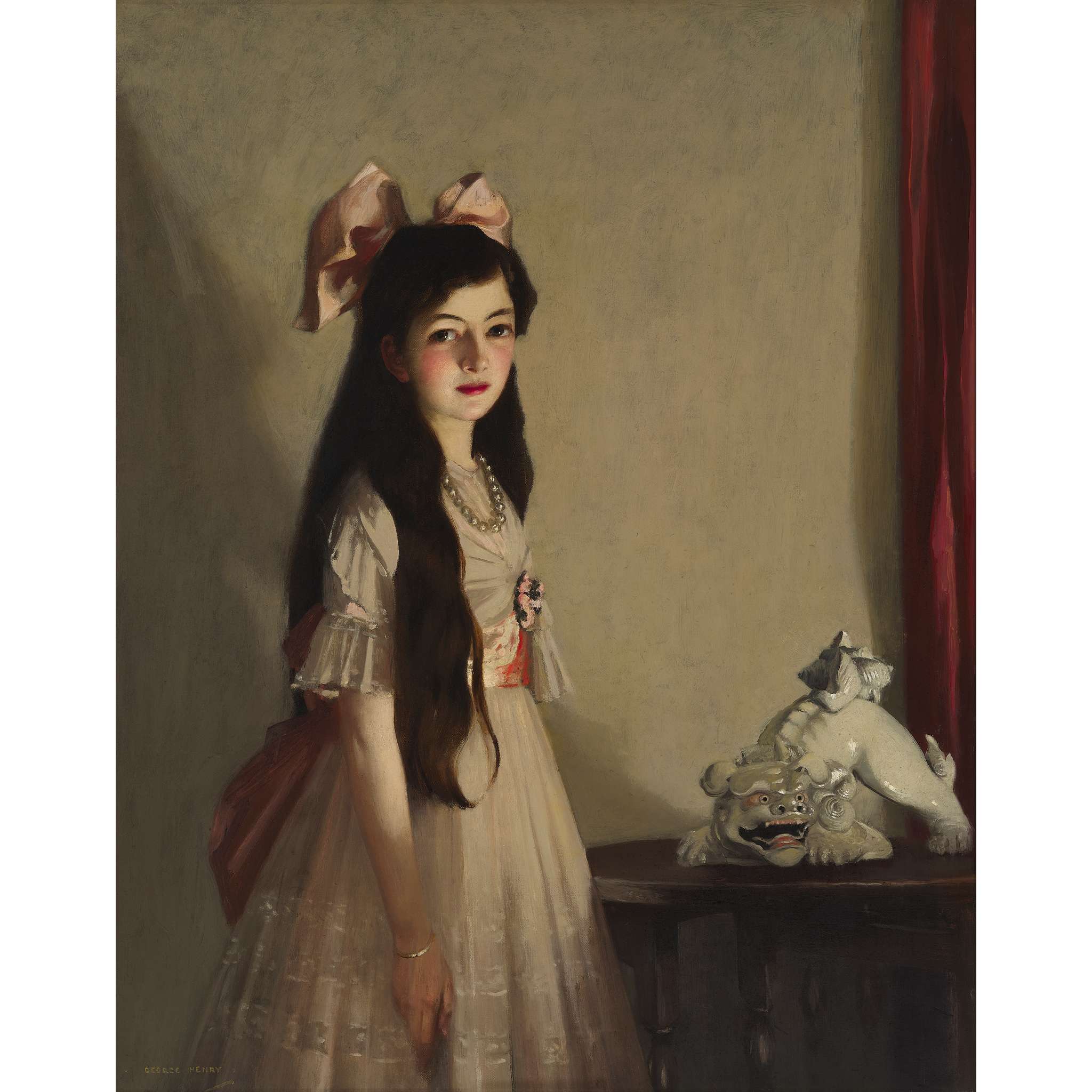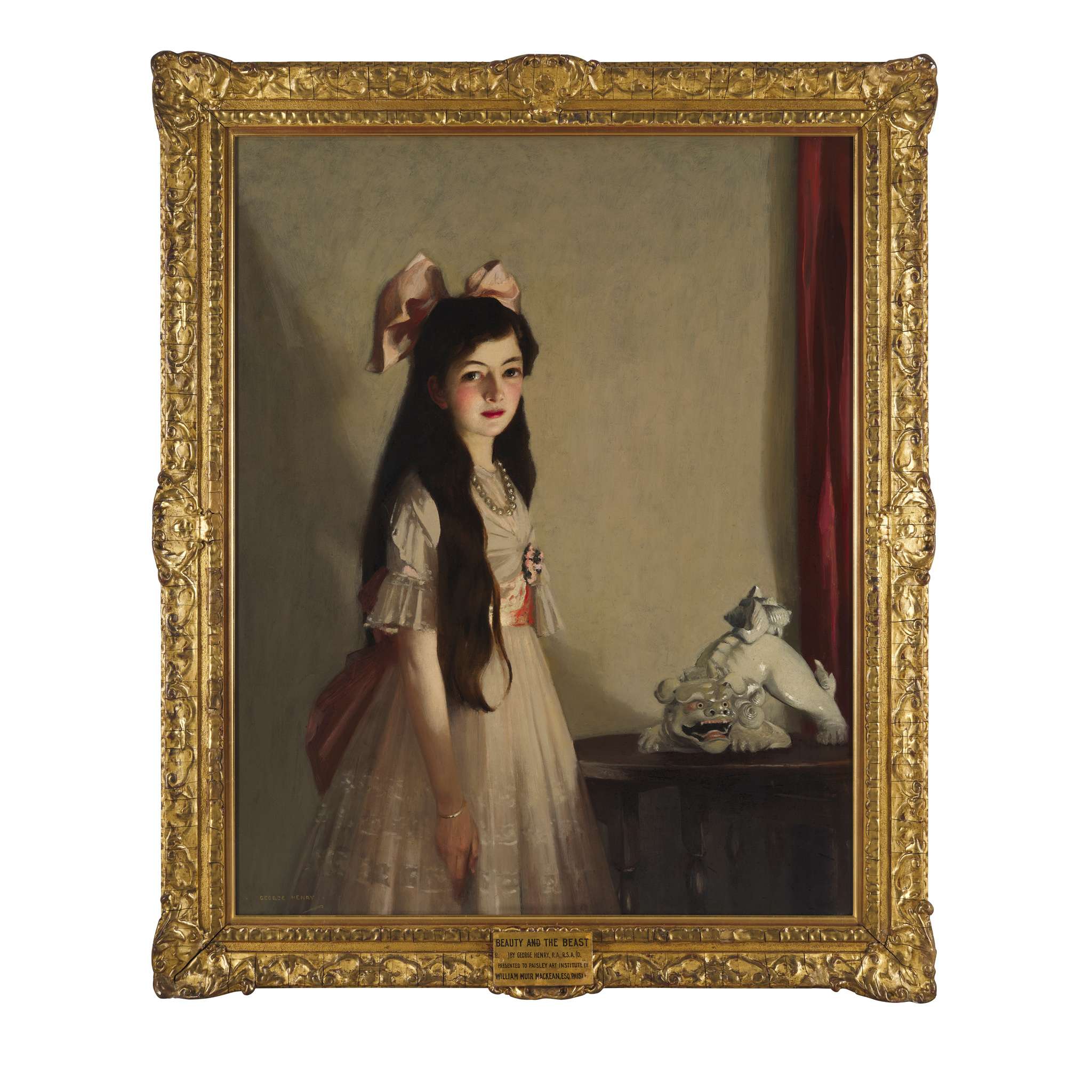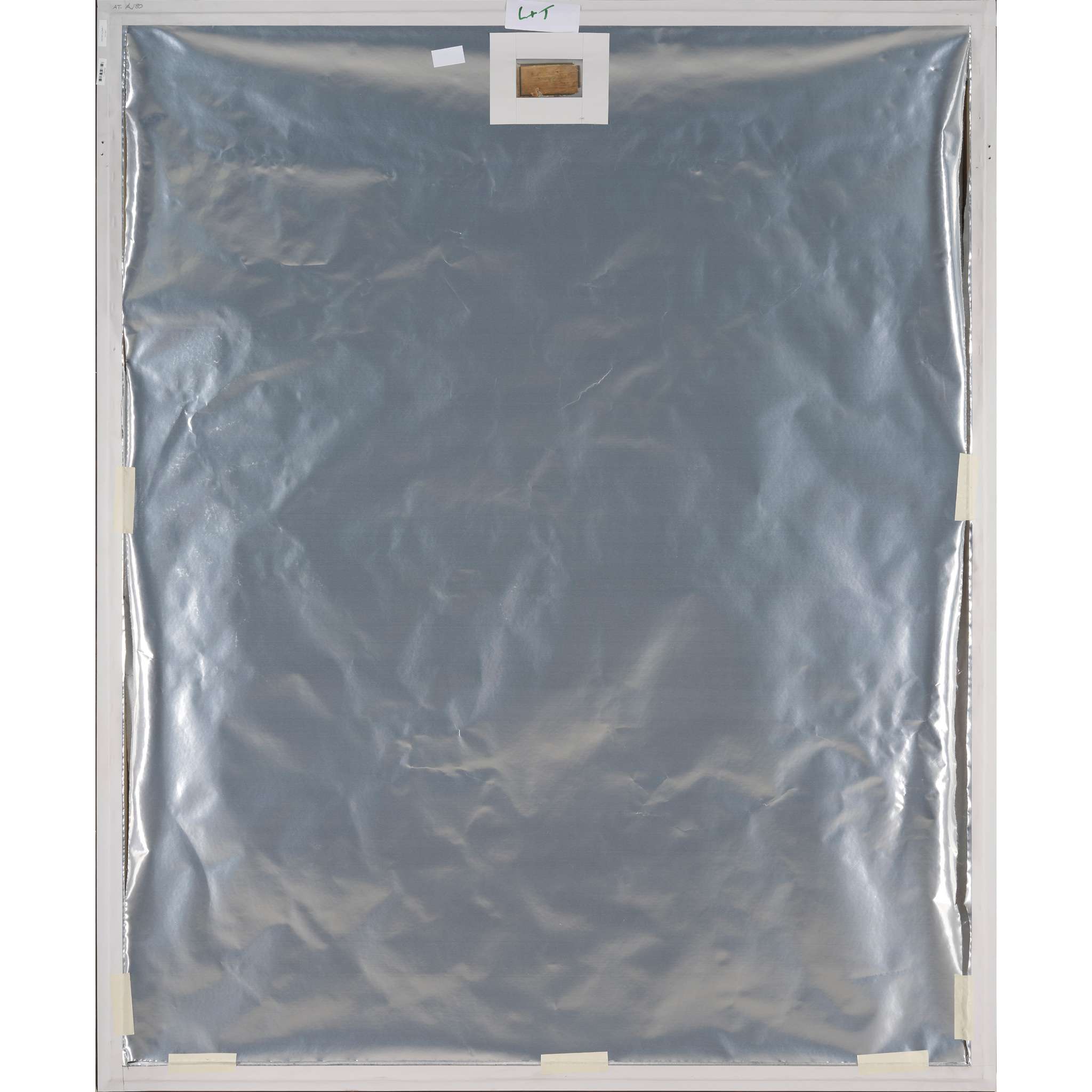160
GEORGE HENRY R.A., R.S.A., R.S.W. (SCOTTISH 1858-1943)
BEAUTY AND THE BEAST
Signed, oil on canvas
122cm x 96.5cm (48in x 38in)
William Muir McKean, PaisleyPresented to Paisley Art Institute by the above in 1932Exhibited: Royal Scottish Academy, Edinburgh, 1944, no. 369Royal Glasgow Institute, 1944, no.293
Of all The Glasgow Boys, George Henry is one of the most notable for the diversity and innovation of his artistic output. From realist works inspired by the French naturalist school, through avant-garde forays into folkloric subject matter that demonstrated an engagement with Symbolism and Post-Impressionism, Henry’s abundant skill encompassed the fast-moving developments in European art at the end of the nineteenth century. A further genre mastered by Henry, though more quietly celebrated by art history books, was his success within the area of society portraiture. Following in the footsteps of Walton, Guthrie and Lavery before him, Henry knew that a reliable income - and indeed public acceptance - lay the way of the society portrait. Initially deployed as a method to raise funds to repay creditors in Glasgow, Henry would ultimately lean into portraiture as the predominant means of supporting his career, trailing his peers to London and establishing a studio there. From 1890 onwards, The Glasgow Boys saw their work gradually absorbed into the Royal Scottish Academy, as well as shown in London’s Royal Academy, New English Art Club and the Grosvenor Gallery with increasing regularity. This was accompanied by press attention and positive critical regard. Success in Europe and America towards the end of the decade lifted their reputations even further and, as their stock rose, so too did the volume of their portrait commissions. The Edwardian era was a popular time for portraiture. In the period immediately preceding the First World War it was undergoing a revival, a ‘luxurious finale’ to a gilded age in Britain. At a time that saw the popularisation of the photographic portrait, a likeness in paint became a more rarified signifier of status. Likewise, an expanding middle class viewed portraiture as a means by which to cultivate their aspirations. Portrait artists held a lot of social cachet in this period. Indeed, it could be said that no respectable dinner party was complete without one. Many, including Whistler, Sargent and Lavery, attained celebrity within society circles. It was felt that a portrait by the right artist had the power to ‘make’ a reputation. Lyon & Turnbull are delighted to present to market two exceptionally fine portraits by George Henry: Beauty and the Beast and Lady with a Green Scarf.Portraiture at the time contained subsets of trends, led in the main by the two greatest figures of influence, Whistler and Sargent. The Glasgow Boys were famously devotees of the Whistlerian aesthetic, and this is most clearly borne out in Beauty and the Beast. This is manifest in the drama of simple shapes against a minimalistic background, the balanced pre-occupations of aestheticism with factual likeness, and above all, the restrained palette of harmonious tones. It is an unusually arresting portrait of a young girl on the cusp of womanhood, in which the artist is playfully overt about the subtext connoted by the painting’s title. The strong, glancing light is nothing short of dramatic, and in impactful contrast with the childlike ‘prettiness’ of the pink bows and white lace of her hair ribbon and dress. The shadows which portentously loom behind the sitter serve to enhance the allegory at the portrait’s heart. Her expression is hard to place – simultaneously direct and reticent, the overall effect being subtly enigmatic. Lady with a Green Scarf, dated 1917, is perhaps more in the manner of Sargent. There is a stronger feeling of Henry’s naturalist roots in the sense of movement in the pose; the figure turning, lost in reverie perhaps, toying with her fan. The space she occupies is not descriptive; instead, the focus is given to the bravura brushwork of the fabulous scarf the sitter wears. This portrait feels less a psychological study of the subject than an artist revelling in his powers as a painter, the former sacrificed to the latter to extremely decorative, rather than detrimental, effect. This brushwork could be seen as a move towards a more modern simplicity in style, all ‘wriggle and chiffon’, as Walter Sickert so superbly summarised the trend at the time.
BEAUTY AND THE BEAST
Signed, oil on canvas
122cm x 96.5cm (48in x 38in)
William Muir McKean, PaisleyPresented to Paisley Art Institute by the above in 1932Exhibited: Royal Scottish Academy, Edinburgh, 1944, no. 369Royal Glasgow Institute, 1944, no.293
Of all The Glasgow Boys, George Henry is one of the most notable for the diversity and innovation of his artistic output. From realist works inspired by the French naturalist school, through avant-garde forays into folkloric subject matter that demonstrated an engagement with Symbolism and Post-Impressionism, Henry’s abundant skill encompassed the fast-moving developments in European art at the end of the nineteenth century. A further genre mastered by Henry, though more quietly celebrated by art history books, was his success within the area of society portraiture. Following in the footsteps of Walton, Guthrie and Lavery before him, Henry knew that a reliable income - and indeed public acceptance - lay the way of the society portrait. Initially deployed as a method to raise funds to repay creditors in Glasgow, Henry would ultimately lean into portraiture as the predominant means of supporting his career, trailing his peers to London and establishing a studio there. From 1890 onwards, The Glasgow Boys saw their work gradually absorbed into the Royal Scottish Academy, as well as shown in London’s Royal Academy, New English Art Club and the Grosvenor Gallery with increasing regularity. This was accompanied by press attention and positive critical regard. Success in Europe and America towards the end of the decade lifted their reputations even further and, as their stock rose, so too did the volume of their portrait commissions. The Edwardian era was a popular time for portraiture. In the period immediately preceding the First World War it was undergoing a revival, a ‘luxurious finale’ to a gilded age in Britain. At a time that saw the popularisation of the photographic portrait, a likeness in paint became a more rarified signifier of status. Likewise, an expanding middle class viewed portraiture as a means by which to cultivate their aspirations. Portrait artists held a lot of social cachet in this period. Indeed, it could be said that no respectable dinner party was complete without one. Many, including Whistler, Sargent and Lavery, attained celebrity within society circles. It was felt that a portrait by the right artist had the power to ‘make’ a reputation. Lyon & Turnbull are delighted to present to market two exceptionally fine portraits by George Henry: Beauty and the Beast and Lady with a Green Scarf.Portraiture at the time contained subsets of trends, led in the main by the two greatest figures of influence, Whistler and Sargent. The Glasgow Boys were famously devotees of the Whistlerian aesthetic, and this is most clearly borne out in Beauty and the Beast. This is manifest in the drama of simple shapes against a minimalistic background, the balanced pre-occupations of aestheticism with factual likeness, and above all, the restrained palette of harmonious tones. It is an unusually arresting portrait of a young girl on the cusp of womanhood, in which the artist is playfully overt about the subtext connoted by the painting’s title. The strong, glancing light is nothing short of dramatic, and in impactful contrast with the childlike ‘prettiness’ of the pink bows and white lace of her hair ribbon and dress. The shadows which portentously loom behind the sitter serve to enhance the allegory at the portrait’s heart. Her expression is hard to place – simultaneously direct and reticent, the overall effect being subtly enigmatic. Lady with a Green Scarf, dated 1917, is perhaps more in the manner of Sargent. There is a stronger feeling of Henry’s naturalist roots in the sense of movement in the pose; the figure turning, lost in reverie perhaps, toying with her fan. The space she occupies is not descriptive; instead, the focus is given to the bravura brushwork of the fabulous scarf the sitter wears. This portrait feels less a psychological study of the subject than an artist revelling in his powers as a painter, the former sacrificed to the latter to extremely decorative, rather than detrimental, effect. This brushwork could be seen as a move towards a more modern simplicity in style, all ‘wriggle and chiffon’, as Walter Sickert so superbly summarised the trend at the time.
Scottish Paintings & Sculpture
Sale Date(s)
Venue Address
All collections are by appointment only (this applies to both carriers and personal collections).
To book or for more information contact info@lyonandturnbull.com or telephone 0131 557 8844.
-----
UK & International - Smaller items and paintings
Art & Antique Delivery Centre
Mail Boxes Etc.
12 South Bridge
Edinburgh, EH1 1DD
T: 0131 556 6226
info@mbeedinburgh.com
Mailboxes Etc
8 Shepherd Market
Mayfair
London, W1J 7JY
Tel: 0207 491 0022
info@mbemayfair.co.uk
Mailboxes Etc
61 Praed Street
London, W2 1NS
Tel: 0207 706 3666
info@mbepaddington.co.uk
Pack & Send Edinburgh East
53 Elm Row
Leith Walk
Edinburgh, EH7 4AH
Tel: 0131 201 2244
edinburgheast@packsend.co.uk
www.packsend.co.uk/edinburgheast
UK - Larger Items
Aardvark Art Services Ltd
Tel: 01253 794 673
info@aardvarkartservices.com
John McVey Distribution Storage & Transport (UK & Ireland)
175 Waddell Street
Drumchapel
Glasgow
G5 0NA
+44(0)141 429 2015
UK & International - Larger Items
Stephen Morris Shipping
Unit 15, Ockham Drive
Greenford, Middlesex
UB6 0FD
+44(0)20 8832 2222
hannah@shipsms.co.uk
Crown Fine Art
Art Central, Union Court
20-22 Union Road
London, SW4 6JP
+44 (0)20 7732 7610
auctionteam.uk@crownww.com
Constantine Moving Services (Specialists in UK & International Shipping)
Constantine House
North Caldeen Road
Coatbridge, ML5 4EF
Tel: 01236 430 681
allanak@constantinemoving.com
A Van Man Transport
Unit 5, Benridge Park
Holyrood Close, Creekmoor
Poole, Dorset, BH17 7BD
Tel: 01202 600 012
office@avmt.co.uk
Gallery Support Group
Unit 4, 89 Manor Farm Road
Wembley
London, HA0 1BA
Tel: 020 305 307 53
info@gallerysupportgroup.com
Important Information
A £6,500 spend limit has been applied to this auction. Bidders intending on spending above this amount will need to provide photo identification to have the spend limit removed. To help manage this, you will be asked to confirm your projected spend as part of the auction registration process. You may receive a request to provide photo ID. We ask that you provide this at your earliest convenience on request, to ensure you are free to bid above the £6,500 spend limit on sale day . Please note it is Lyon and Turnbull’s discretion to ask for identification – you will be also asked to provide this if you have no bidding history.
BUYER'S PREMIUM
The buyer shall pay the hammer price together with a premium, at the following rate, thereon.
26% up to £20,000
25% from £20,001 to £500,000
20% thereafter
VAT will be charged on the premium at the rate imposed by law (see our Conditions of Sale at the back of this catalogue).
ADDITIONAL VAT
† VAT at the standard rate payable on the hammer price
‡ Reduced rate of 5% import VAT payable on the hammer price
[Ω] Standard rate of import VAT on the hammer price
Lots affixed with ‡ or [Ω] symbols may be subject to further regulations upon export /import, please see Conditions of Sale for Buyers Section D.2.
No VAT is payable on the hammer price or premium for books bought at auction
REGISTRATION
All potential buyers must register prior to placing a bid. Paddle registration must be completed in advance of the sale day. Please note that all first-time, and those returning after an extended period, bidders at Lyon & Turnbull will be asked to supply the following documents in order to facilitate registration:
1 – Government issued photo ID (Passport/Driving licence)
2 – Proof of address (utility bill/bank statement).
By registering for the sale, the buyer acknowledges that he or she has read, understood and accepted our Conditions of Sale.
ARTIST’S RESALE ROYALTY (DROIT DE SUITE)
This symbol § indicates works which may be subject to the Droit de Suite or Artist’s Resale Right, which took effect in the United Kingdom on 14th February 2006. We are required to collect a royalty payment for all qualifying works of art. Under new legislation which came into effect on 1st January 2012 this applies to living artists and artists who have died in the last 70 years. This royalty will be charged to the Buyer on the Hammer Price and in addition to the Buyer’s Premium. It will not apply to works where the Hammer Price is less than £1,000. The charge for works of art sold at and above £1,000 and below £50,000 is 4%. For items selling above £50,000, charges are calculated on a sliding scale. All royalty charges are paid to the Design and Artists Copyright Society (‘DACS’) and no handling costs or additional fees are retained by the Auctioneer. Resale royalties are not subject to VAT. Please note that the royalty payment is calculated on the rate of exchange at the European Central Bank on the date of the sale. More information on Droit de Suite is available at www.dacs.org.uk.
REMOVAL OF PURCHASES
Responsibility for packing, shipping and insurance shall be exclusively that of the purchaser. See Collections & Storage section for more info specific to this particular auction.
CATALOGUE DESCRIPTIONS
All item descriptions, dimensions and estimates are provided for guidance only. It is the buyer’s responsibility to inspect all lots prior to bidding to ensure that the condition is to their satisfaction. Our specialists will be happy to prepare condition reports and additional images. These are for guidance only and all lots are sold ‘as found’, as per our Conditions of Sale.
IMPORT/EXPORT
Prospective buyers are advised that several countries prohibit the importation of property containing materials from endangered species, including but not limited to; rosewood, rhino horn, ivory, coral and tortoiseshell. Accordingly, prospective buyers should familiarise themselves with all relevant customs regulations prior to bidding if they intend to import lots to another country. It is the buyer’s sole responsibility to obtain any relevant export or import licence. The denial of any licence or any delay in obtaining licences shall neither justify the recession of any sale nor any delay in making full payment for the lot.
ENDANGERED SPECIES
Please be aware that lots marked with the symbol Y contain material which may be subject to CITES regulations when exporting outside Great Britain. For more information visit https://www.defra.gov.uk/ahvla-en/imports-exports/cites
Terms & Conditions
UK - Conditions Of Sale For Buyers
These Conditions of Sale and the Saleroom Notices as well as specific Catalogue terms, set out the terms on which we offer the Lots listed in this Catalogue for sale. By registering to bid and/or by bidding at auction You agree to these terms, we recommend that You read them carefully before doing so. You will find a list of definitions and a glossary at the end providing explanations for the meanings of the words and expressions used.
Special terms may be used in Catalogue descriptions of particular classes of items (Books, Jewellery, Paintings, Guns, Firearms, etc.) in which case the descriptions must be interpreted in accordance with any glossary appearing in the Catalogue. These notices and terms will also form part of our terms and conditions of sales.
In these Conditions the words “Us”, “Our”, “We” etc. refers to Lyon & Turnbull Ltd, the singular includes the plural and vice versa as appropriate. “You”, “Your” means the Buyer.
Lyon & Turnbull Ltd. acts as agent for the Seller. On occasion where Lyon & Turnbull Ltd. own a lot in part or full the property will be identified in the catalogue with the symbol (












